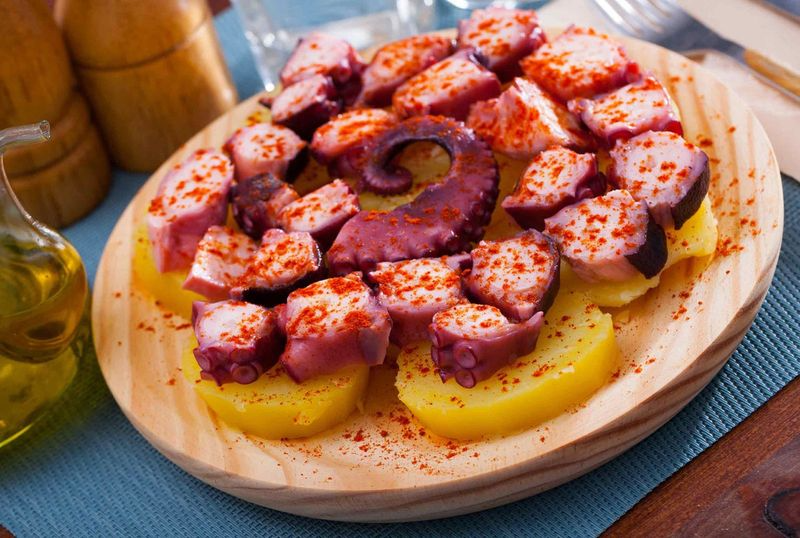Tucked away in the windswept coastal region of Galicia in northern Spain lies a culinary gem so deeply intertwined with its roots that every bite feels like a sea breeze brushing across your cheeks.
This dish isn’t flashy. It doesn’t shout for attention. Instead, it quietly commands your respect—through its simplicity, its heritage, and its undeniable flavor. Welcome to the world of Pulpo a la Gallega.
Also known as Polbo á Feira in Galician, this rustic octopus dish is a masterclass in minimalism. It’s a testament to the belief that when ingredients are fresh and prepared with care, you don’t need much else.
A few humble components—octopus, potatoes, olive oil, paprika, and sea salt—come together to create something far greater than the sum of its parts.
But before we dive fork-first into the preparation, let’s take a moment to understand the soul of this dish.
A Dish Born of the Sea
Galicia, with its rugged cliffs and foamy Atlantic waves, has always lived hand-in-hand with the sea. The ocean is both larder and lifeblood, shaping the culture, economy, and—of course—the food. Pulpo a la Gallega was once a festival food, often served at local fairs and religious celebrations. Today, you’ll find it everywhere from tapas bars to Michelin-starred restaurants across Spain, but its roots remain humble.
Traditionally served on round wooden plates with toothpicks instead of forks, the dish’s presentation is just as straightforward as its ingredients. No garnish. No fancy flair. Just honest food, prepared with reverence.
Let’s bring this Galician treasure to your table.
Recipe: Pulpo a la Gallega (Galician-Style Octopus)
Serves: 4
Preparation Time: 20 minutes (plus optional freezing)
Cooking Time: 1 hour 15 minutes
Total Time: 1 hour 35 minutes
Ingredients:
- 1 whole octopus (about 2 to 2.5 pounds), cleaned
- 2-3 medium Yukon Gold potatoes, peeled and cut into thick slices
- 2 tablespoons high-quality Spanish olive oil (extra virgin, if possible)
- 1 to 2 teaspoons Spanish smoked paprika (preferably pimentón de la Vera)
- Flaky sea salt (like Maldon or flor de sal), to taste
- Bay leaves (2-3)
- Optional: whole peppercorns or a splash of vinegar for the boiling water
Preparation:
Step 1: Tenderizing the Octopus
Now, here’s the not-so-secret trick to tender octopus: freeze it first. Yes, really. If you’re working with fresh octopus, pop it in the freezer for 24 hours before cooking.
This breaks down tough fibers and mimics the traditional Galician method of beating it with a wooden mallet. If your octopus is already frozen, congratulations—you’re ahead of the game.
Step 2: The Famous “Scare the Octopus” Technique
Bring a large pot of water to a boil. Add a few bay leaves and, if you like, a splash of vinegar and some peppercorns for extra flavor.
Now comes a traditional and theatrical touch: asustar el pulpo—“scaring the octopus.” Hold the octopus by the head, dip it into the boiling water for 3 seconds, and pull it out.
Repeat this dipping process two more times. This causes the tentacles to curl dramatically and gives the octopus that signature Galician look. After the third dip, fully submerge the octopus and let it cook.
Step 3: Boil to Perfection
Reduce the heat to a gentle simmer. Let the octopus cook for 45–60 minutes, depending on its size. Don’t rush it, and don’t cover the pot. You’ll know it’s ready when you can easily pierce the thickest part of a tentacle with a knife.
Once cooked, remove the octopus and let it rest for 10 minutes. Don’t discard the water just yet.
Step 4: Boil the Potatoes
While the octopus rests, add the potato slices to the same water. Cook until fork-tender—about 15 minutes. The octopus-infused water subtly seasons the potatoes and ties the dish together beautifully.
Step 5: Assemble and Finish
Slice the octopus tentacles into ½-inch rounds. Arrange the potato slices on a serving platter or, if you want to honor tradition, a round wooden plate. Layer the octopus slices on top.
Now, for the crowning touches: drizzle generously with good olive oil. Sprinkle liberally with smoky paprika. Finish with flaky sea salt, letting it fall like snow over the tender morsels.
Serving Suggestions and Tips
- Pulpo a la Gallega is best served warm or at room temperature—not piping hot.
- Pair it with a chilled glass of Albariño, a crisp white wine native to Galicia. Its minerality complements the octopus perfectly.
- If you’re feeling festive, serve the dish with rustic bread and a few olives on the side. No silverware necessary—just toothpicks and good conversation.
When you make Pulpo a la Gallega, you’re not just cooking octopus—you’re channeling generations of Galician tradition.
This is the food of mariners, of village fairs, of family gatherings held under the whispering Atlantic breeze. It’s a dish that embraces restraint and rewards patience, one that teaches us to appreciate quality over complexity.
And once you taste it—that silky, smoky, briny bite—you’ll understand why this humble plate has earned a place in the heart of Spanish cuisine.

Leave a comment